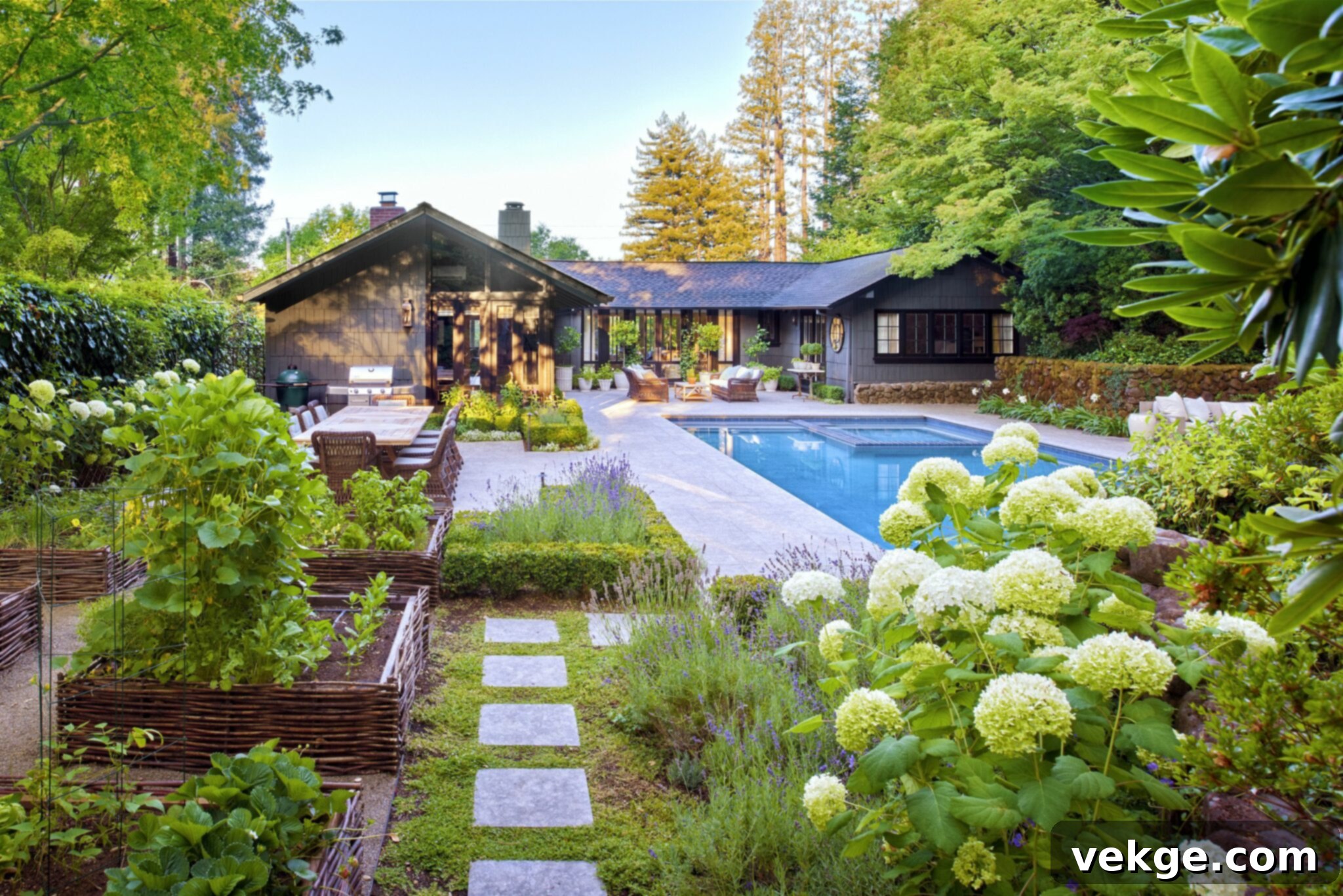Transform Your Backyard into a Sustainable Oasis: Design for Nature, Tranquility & Comfort
Imagine stepping outside into your personal oasis, where the gentle rustling of leaves, the melodious chirping of birds, and the soft caress of a breeze against your skin all combine to create a harmonious environment. This symphony of nature envelops you in a peaceful embrace, soothing your soul and rejuvenating your spirit. In today’s fast-paced world, finding solace in nature has become more important than ever, making the creation of your outdoor haven not just a luxury, but a necessity for holistic well-being.
Crafting this sanctuary goes beyond merely placing some furniture on a patio. It demands thoughtful planning and a design approach that seamlessly integrates with the natural elements surrounding your home. From carefully selecting native plants that attract butterflies and songbirds to incorporating sustainable materials into your outdoor decor, every decision you make has the potential to enhance the harmony between human living and the natural world, right in your own backyard.
Join us on a comprehensive journey to create an outdoor space that not only beautifully reflects your personality and lifestyle but also respects, celebrates, and contributes to the beauty and health of our precious natural environment. Discover how mindful design can transform your outdoor area into a vibrant, sustainable, and utterly tranquil retreat.
Cultivating a Sustainable Oasis
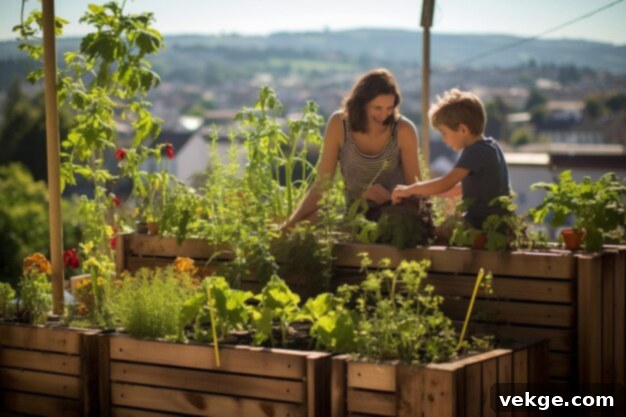
Picture yourself stepping barefoot onto a lush lawn, surrounded by vibrant native plants, the air crisp and clean, invigorating your senses. The gentle rustle of leaves and the cheerful chirping of birds create a perpetually calming environment. Cultivating such a sustainable haven requires careful planning, informed choices, and a commitment to ecological balance. It’s about designing a space that thrives with minimal external intervention, working in concert with nature rather than against it.
Begin by selecting native plants that are perfectly suited to your specific climate and soil conditions. This simple choice significantly reduces the need for excessive watering, chemical fertilizers, or pest treatments, as these plants have naturally adapted to local conditions. Integrating practical elements like rain barrels allows you to harvest rainwater for irrigation, while compost bins turn organic waste into nutrient-rich soil amendments, nourishing your garden naturally and minimizing landfill waste. To truly elevate your sustainable oasis, consider incorporating renewable energy sources. Solar panels can power outdoor lighting, fountains, or other water features, further reducing your environmental footprint. Embracing the beauty of imperfection and allowing natural processes like decomposition and habitat creation to flourish within your space fosters a dynamic and resilient ecosystem.
By nurturing biodiversity through diverse plantings and creating wildlife-friendly habitats, you invite balance into your oasis. This approach creates a symbiotic relationship with nature, where your garden provides a home for local fauna, and in turn, they contribute to the health and vitality of your plants. For expert guidance in creating such a landscape, consider hiring landscaping professionals like https://gtasunrise.com/, who can help you design and implement a truly sustainable and thriving outdoor space. This holistic approach ensures your garden not only sustains itself but also enriches your soul with its beauty and vitality.
Selecting Plant Life for Harmony and Biodiversity
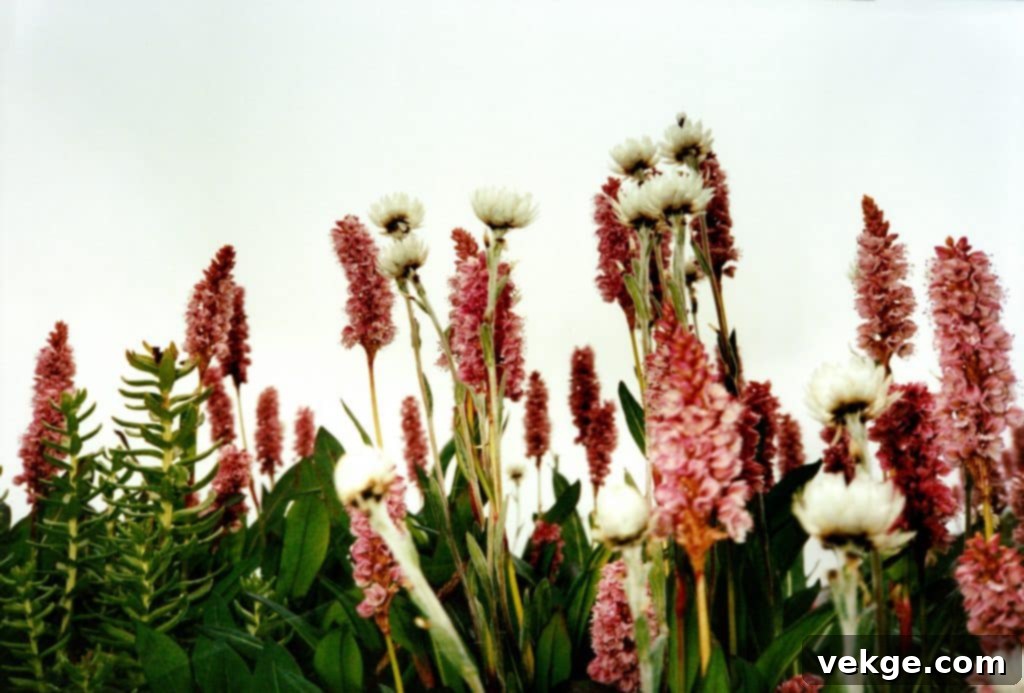
When curating the plant life for your outdoor space, the concept of biodiversity should be at the forefront of your mind. It’s not merely about aesthetic appeal but about fostering a balanced and resilient ecosystem. A diverse array of plant species acts as a magnet for various pollinators like bees and butterflies, birds seeking shelter and food, and beneficial insects that help control pests naturally. This interconnected web of life creates a harmonious environment that significantly supports overall ecological health within your garden.
Prioritize selecting plants based on their native habitat and growing conditions. Native plants are inherently adapted to local climate, soil, and precipitation patterns, making them more resilient and less demanding in terms of water and care. This approach helps establish a self-sustaining ecosystem that requires minimal intervention once established. Don’t hesitate to mix different types of plants, creating contrast in colors, textures, and heights. This not only adds immense visual appeal but also supports biodiversity by offering varied food sources and habitats. Incorporating trees, shrubs, perennials, and annuals into your landscaping design provides multiple layers of habitats, from the canopy to the undergrowth, inviting a broader range of creatures and creating a dynamic ecosystem teeming with life.
Furthermore, embrace the natural cycles of growth and decay. Allowing fallen leaves, branches, and other organic matter to decompose naturally enriches the soil, creating a thriving microcosm of beneficial fungi, bacteria, and invertebrates beneath the surface. This continuous nutrient cycling is vital for a healthy, self-sustaining garden. By carefully selecting plant life with biodiversity in mind, you are not just gardening; you are actively participating in the conservation and preservation of our natural world. Let your outdoor space become a sanctuary where harmony reigns supreme, sustained by the intricate and interconnected web of plant species that supports all forms of life around it.
Embracing Eco-Friendly Materials in Your Outdoor Design
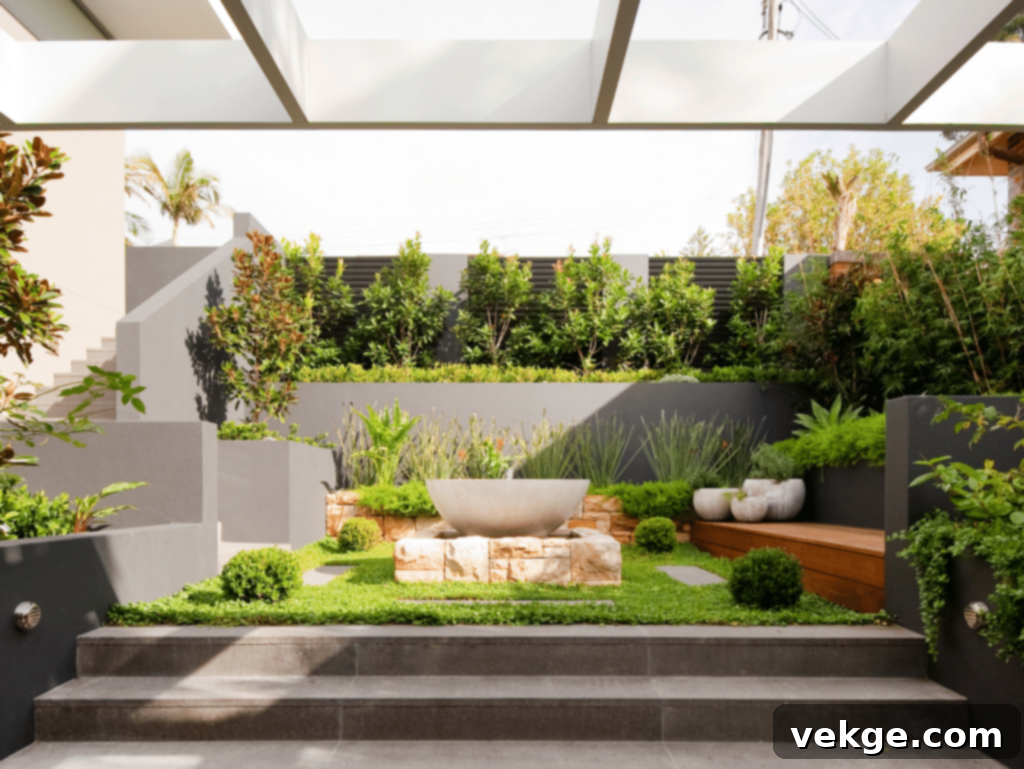
In a world where sustainability is rapidly becoming a critical imperative, the conscious choice to embrace eco-friendly materials in your outdoor design transcends mere aesthetics; it becomes a powerful statement of environmentally responsible living. Imagine a garden adorned with robust furniture crafted from reclaimed wood, each piece telling a story, or a patio laid with porous and permeable pavers. These innovative pavers allow rainwater to seep naturally back into the ground, recharging aquifers and preventing destructive runoff into storm drains. Such choices not only enhance the natural beauty and character of your outdoor space but also contribute significantly and positively to our planet’s overall well-being.
Opting for sustainable materials such as fast-growing bamboo, durable recycled plastics, or beautifully repurposed reclaimed metals in your outdoor design serves multiple environmental benefits. It dramatically reduces waste, diverting materials from landfills, and minimizes your carbon footprint by lessening the demand for virgin resources and energy-intensive manufacturing processes. Furthermore, many eco-friendly materials are locally sourced, which further cuts down on transportation emissions. By consciously selecting materials that are renewable, biodegradable, recycled, or upcycled, you are not just creating an eco-conscious space; you are actively participating in the global movement towards responsible consumption and mindful living.
Consider the lifecycle of every material you bring into your outdoor haven. From responsibly harvested timber for decking to recycled glass aggregates for pathways, each element can echo the gentle whispers of sustainable practices and mindful consumption. Let your outdoor sanctuary be a testament to harmony with nature, a space where every design choice reflects a deep respect for the environment and contributes to a healthier, more beautiful world.
Designing for Tranquility and Comfort
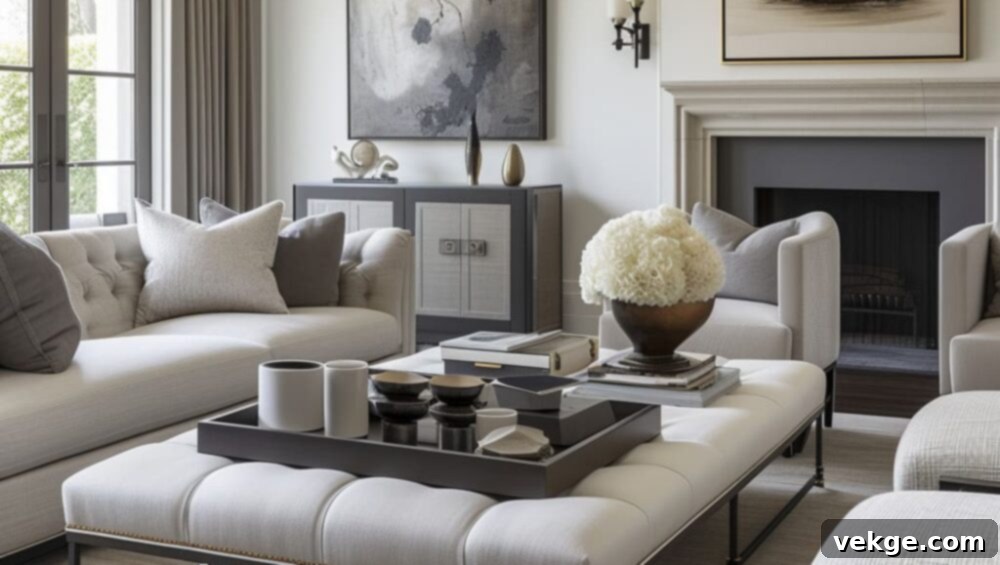
When designing an outdoor space with tranquility and comfort as the core objectives, it’s essential to meticulously consider how natural elements can contribute to a profound sense of calm and relaxation. The interplay of sight, sound, and touch can transform a simple backyard into a deeply restorative retreat. Incorporating water features, for instance, such as a gently bubbling fountain, a reflective bird bath, or a serene small pond, can immediately create a soothing ambiance. The consistent, soft sound of trickling or flowing water naturally masks unwanted urban noises, offering a peaceful auditory backdrop for relaxation and contemplation.
Beyond auditory comfort, physical comfort is paramount. Soft, plush seating options are indispensable; think inviting lounge chairs with generous cushions, comfortable daybeds, or classic hammocks that gently sway. These elements invite you to sink in, relax deeply, and encourage extended moments of contemplation, reading, or simply enjoying the natural surroundings. Strategic placement, perhaps under the dappled shade of a tree or within a secluded nook, enhances the feeling of a private escape.
In addition to physical comfort, paying meticulous attention to visual aesthetics plays a crucial role in enhancing tranquility. Opting for a color palette inspired by nature is key—soft greens, calming blues, warm earth tones, and muted grays can evoke feelings of serenity and harmony, seamlessly blending the built environment with the natural landscape. Strategic placement of plants and greenery can also provide crucial privacy and a sense of seclusion, creating ‘rooms’ within your outdoor space. Tall hedges, climbing vines, or strategically placed trees can act as living screens, further fostering a tranquil and intimate atmosphere within your outdoor haven, allowing you to truly disconnect and unwind.
Creating Inviting Seating Areas for Relaxation

Picture in your mind a tranquil oasis in your backyard, where the accumulated stress of the day effortlessly melts away as you sink into a plush chair, surrounded by nature’s soothing symphony. To genuinely create an inviting seating area for relaxation, it’s crucial to think beyond mere aesthetics and intensely focus on comfort, functionality, and the creation of distinct ‘zones’ for various activities. Consider adding layers of comfort with elements like generously sized, weather-resistant soft cushions, cozy throws for cooler evenings, and carefully designed ambient lighting that casts a warm, inviting glow, all enhancing the sense of tranquility and intimacy.
Incorporating natural elements into your furniture choices, such as rustic wooden benches, elegant wicker chairs, or stone accents, can blend seamlessly with your outdoor space, fostering a harmonious and integrated ambiance. The layout is also key: arrange furniture to encourage conversation and provide ample personal space. Perhaps a cozy two-seater bench nestled in a garden corner for quiet contemplation, or a larger sectional around a fire pit for social gatherings. Strategically placed plants and flowers, acting as natural dividers or backdrops, can evoke a profound sense of serenity and deepen your connection with nature. Think about privacy as well; climbing plants on a trellis or a low hedge can create a sense of enclosure without completely blocking views.
Remember, the ultimate goal in crafting a truly welcoming outdoor haven lies in creating a space that not only looks beautiful but actively beckons you to unwind, rejuvenate, and find peace amidst the stunning beauty of the outdoors, making it an irresistible escape from the everyday.
Incorporating Water Features for Serenity and Sensory Appeal
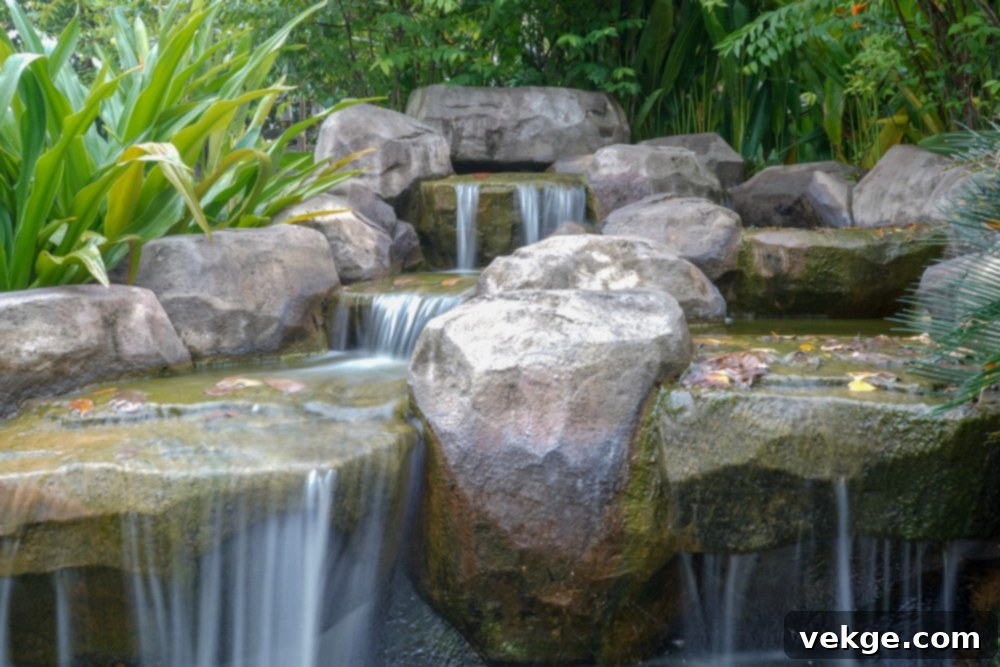
Water features possess an almost magical ability to transform ordinary outdoor spaces into truly tranquil retreats, inviting deep serenity and captivating sensory delight. The omnipresent, gentle sound of water—whether cascading from an elegantly designed fountain, bubbling softly in a pond, or flowing along a miniature stream—creates an inherently soothing ambiance that calms the mind and spirit. This natural white noise subtly masks urban disturbances, allowing you to immerse yourself fully in the peace of your garden. Incorporating various water elements, such as reflective ponds, meandering streams, or dramatic waterfalls, not only adds profound visual interest and a focal point but also engages multiple senses, providing a richer, multidimensional experience for anyone enjoying the outdoor haven.
The presence of water in a garden or backyard can evoke powerful emotional responses, forging a deeper connection between people and nature. A still pond’s glassy surface acts as a living mirror, beautifully reflecting the verdant embrace of surrounding greenery, the changing sky, and the soft light, fostering a profound sense of oneness with the natural world. Beyond their aesthetic and auditory appeal, water features significantly attract local wildlife. Birds flock to bathe and drink, butterflies flutter nearby, and dragonflies may dance over the surface, all contributing to the dynamic life and enhanced sensory appeal of your outdoor space.
When designing your water feature, consider its scale, location, and the type of sound you wish to achieve. A small, bubbling urn might be perfect for a quiet corner, while a larger waterfall could create a more dramatic statement. Maintenance, while usually straightforward, should also be considered. By carefully designing and integrating these life-giving water elements within your outdoor oasis, you can create a peaceful sanctuary that rejuvenates both body and soul, offering an endless source of calm and natural beauty. More ideas and inspirations for stunning water features may be found on site.
Illuminating Your Outdoor Haven: Strategic Lighting for Ambiance and Safety
Just as interior lighting defines the mood of a room, carefully planned outdoor lighting transforms your backyard into an enchanting and safe space after sunset. Strategic illumination can highlight architectural features, accentuate your lush landscaping, and create intimate zones for evening relaxation or entertainment. Beyond aesthetics, proper lighting is crucial for safety, guiding pathways and steps while deterring unwanted visitors.
Consider a multi-layered approach to outdoor lighting. Ambient lighting, such as string lights or diffused lanterns, creates a soft, overall glow that sets a relaxed atmosphere. Task lighting is essential for functional areas like an outdoor kitchen or dining space, ensuring visibility for meal prep and enjoyment. Accent lighting, perhaps focused on a striking tree, a sculpture, or a water feature, draws the eye and adds dramatic flair. Path lighting ensures safe navigation, while security lighting, often motion-activated, provides peace of mind.
Embrace energy-efficient options like LED lights, which consume less power and have a longer lifespan, reducing both your electricity bill and environmental impact. Solar-powered lights are an excellent sustainable choice for pathways and accent lighting, requiring no wiring and utilizing renewable energy. Smart lighting systems offer convenience, allowing you to control brightness, color, and timers from your smartphone, adapting your outdoor ambiance with ease. By thoughtfully integrating these lighting elements, your outdoor oasis remains a welcoming and beautiful extension of your home, long after the sun goes down.
Personalizing Your Outdoor Sanctuary: Adding Unique Touches
Your outdoor oasis should be a true reflection of your personality and passions, a space that feels uniquely yours. Personalization is what transforms a well-designed garden into a cherished sanctuary. Think beyond standard furniture and plants, and consider elements that speak to your individual style and enhance your enjoyment of the space.
Art and sculptures can add a focal point and a touch of artistic flair. Whether it’s a rustic metal sculpture, a whimsical ceramic piece, or a calming Zen garden feature, choose items that resonate with you. Fire pits or outdoor fireplaces are not just functional for warmth; they become natural gathering points, fostering conversation and creating a cozy, primitive ambiance under the stars. For the culinary enthusiast, an outdoor kitchen or a dedicated BBQ station can turn your patio into a vibrant hub for entertaining and al fresco dining.
Consider incorporating elements that engage your hobbies or interests. A small herb garden near the kitchen door provides fresh ingredients and delightful aromas. A comfortable reading nook with a weather-resistant bookshelf caters to bookworms. Even the choice of cushions, planters, or decorative accessories can infuse your personal style. By carefully selecting and arranging these unique touches, you infuse your outdoor space with character and warmth, creating a sanctuary that not only connects you with nature but also deeply connects with you.
Year-Round Enjoyment and Sustainable Maintenance
A truly exceptional outdoor oasis is one that can be enjoyed throughout the seasons, with a maintenance plan that aligns with sustainable principles. Designing for year-round appeal involves thoughtful plant selection and strategic protection from the elements. Choose a variety of plants that offer interest across different seasons, from spring blooms to summer foliage, autumn colors, and winter evergreens. Consider adding a sheltered seating area, perhaps with a retractable awning or a covered pergola, to extend the usable season of your outdoor space, allowing enjoyment even on cooler or rainy days.
Sustainable maintenance practices are key to preserving the health and beauty of your oasis without harming the environment. Minimize the use of synthetic fertilizers and pesticides, opting instead for organic alternatives, composting, and companion planting to naturally manage pests and enrich the soil. Efficient irrigation systems, such as drip lines or smart controllers that adjust watering based on weather, significantly reduce water waste. Regular mulching helps retain soil moisture, suppress weeds, and regulate soil temperature. By embracing these eco-friendly maintenance habits, you ensure your outdoor sanctuary remains vibrant, healthy, and a continuous source of joy for years to come, harmonizing with the natural world.
